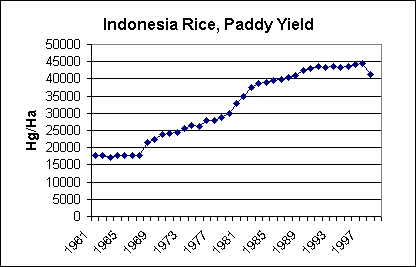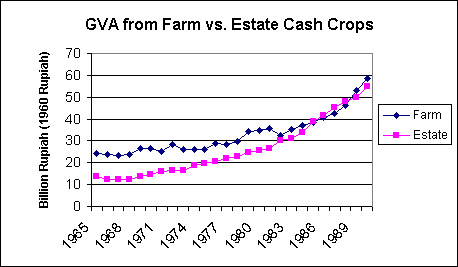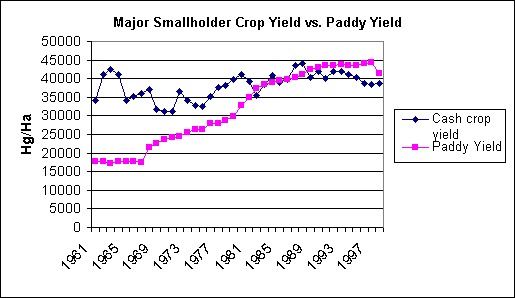
Source: FAO Statistical Database
A. Agricultural Policy in Indonesia after 1965
Agriculture was a central focus of New Order development strategies and priorities. The New Order was the name given to the government under President Suharto, who succeeded President Sukarno in the aftermath of an attempted communist coup in 1965. Indonesia’s nutritional level was among the lowest in Asia when Suharto officially took power in 1967, and the average supply of calories was less than 80% of basic requirements. The first priority was to develop food crops (crops primarily for domestic consumption), and there was less focus on cash crops (crops primarily for export).
Among the food crops given special developmental assistance, rice was primary. Rice was more than a staple in Indonesia; it dominated the political economy of the country. The price and availability of rice had an important bearing on political stability of Suharto’s regime. Rice shortages were part of the general economic malaise that contributed to the fall of Sukarno. The meaning of rice in Indonesia goes beyond its status as the nation’s principal staple. Most Indonesian’s eat it at every meal; in fact, many feel they have not actually eaten a meal if rice is not part of it. An example that demonstrates the population’s commitment to rice consumption occurred in 1963, by which time several attempts at rice self-sufficiency had failed. Sukarno launched a personal campaign to urge the population to eat maize and other foods in place of rice, but the public outcry was so great that the idea was dropped.
Additionally, rice plays an important economic role, since it is the main product of the villages of Java. It is the livelihood for a large part of the rural population, which constitutes 65% of the total population. This points to the favoritism that Javanese farmers have received over those in the outer islands. Suharto’s government favored the development of Java; the most modern cities and productive farmers are on Java and dominated by the Javanese. Java is the center of business and government, and perceived by those in power as the core of the nation. This perception has caused grievances among the outer islands’ inhabitants, as resources are continuously poured into Jakarta. This situation persisted throughout Suharto’s rule.
Suharto took action on achieving rice self-sufficiency within months of his takeover of the presidency. The government provided several input subsidies for fertilizer, pesticides, and irrigation, which helped to increase yields and production. Farmers were given easy credit terms, and were assisted with programs such as "mass guidance," which were meant to help farmers implement new technologies and rice varieties developed in the neighboring countries of Philippines, Thailand, and Malaysia. The government invested heavily in rural infrastructure, such as irrigation canals, water supply, bridges, roads, and major highways. Other programs for primary schools, health centers, markets, and reforestation were also established. By 1978, programs to build up the local infrastructure amounted to 12% of the national development budget, a positive repercussion of the importance of rice to political stability. By 1984, production of rice exceeded domestic consumption for the first time.
Events in the international environment also assisted the growth of rice production. Of the new technologies mentioned above, new rice hybrids developed in the Philippines had the largest impact, since they had the potential of increasing the traditional yields of irrigated land in tropical Asia many times over. This hybrid was the beginning of what became known as the "green revolution." In addition to this, the oil crisis of the early 1970s increased the price of Indonesia’s crude oil by 200% in international markets. This new oil money helped to fund the above improvements, and gave top policymakers freedom to attack the rice problem. They also used this opportunity to solidify their control of nearly every aspect of rice production, and in doing so protect the reputation of the regime, which was vulnerable to public outcry and student demonstrations if rice was not available at a fair price.
BULOG
The institution that probably had the biggest impact on rice production was Bulog, an acronym for Badan Urusan Logistik (National Logistics Agency). When it was created in 1967, it had the responsibility of purchasing rice for the provisioning of the armed forces, the civil service, and state corporation employees. The agency reported directly to the president, and was given monopoly control over prices and production of rice. Now, its control has been expanded to other basic commodities, including wheat, wheat and rice flour, poultry, peanuts, mungbeans, garlic, soybeans, sugar, onion, shallots, and leeks. Bulog assisted rice production by setting price floors and ceilings, thus maintaining the stability of the price of rice. As price floors were raised and other subsidies continued, national production went up, and by the 1980s, Indonesia became self-sufficient in rice.
Bulog is considered by some the most powerful food agency in Asia. Its success is partly attributed to the people in the organization; the second head of the agency, Bustanil Arifin, is credited with turning Bulog into a competent organization and putting the public need ahead of personal and bureaucratic interest. Bulog was also staffed with the most educated, elite, well-trained, and well-paid employees of the state corporate sector, who were given maximum benefits and modern facilities in which to do their work. In addition to human resources, Bulog’s success can be attributed to favorable terms of credit, with which it could purchase imported rice from the government at subsidized costs (in the earlier years, before self-sufficiency). Bulog’s power grew as it set up a reliable information system to disperse information about prices and production around the country, built warehouses to successfully control rice storage, and implemented price supports to protect price stability.
Bulog has come under criticism, however, beginning with its entry into the sugar industry. The government set the price that cane farmers were to be paid at harvest; Bulog bought the cane, contracted with government-owned mills to process it, and managed its trade. Farmers complained that prices were too low, and consumers, that prices were too high. By 1987, the World Bank criticized the entire management of the industry. As was also true in the wheat flour industry (which was also under attack by the World Bank), sugar millers were receiving unusually high profit margins, upwards of 25%. (Bresnan, 1993)
Bulog was given considerable favoritism and never held accountable for its management of substantial government funds and massive quantities of goods. It appears that as long as Bulog was able to successfully manage rice, Suharto left the agency alone. This led to widespread corruption, financial mismanagement, inefficiencies, and pricing that underpaid farmers and overcharged consumers. Since then, the World Bank has urged Bulog to pare back its monopoly control over commodities, criticizing it for regulations which distort prices and business opportunities, thereby increasing costs and causing losses in efficiency as resources become attracted to protected activities.
The recent currency crisis in Asia may be the final straw for Bulog. Indonesia has received economic aid from the IMF, which gives the IMF and World Bank leverage to pressure Indonesia to dismantle monopolies such as Bulog. In response to this pressure, the government of Indonesia has stated that it plans to remove the Bulog monopoly, allowing consumers to buy commodities at market prices. (Jakarta Post, 8/21/97) However, the Indonesian government has vacillated on this declaration, since the destabilizing effects of the currency crisis and severe drought conditions (brought about by El Nino) have driven up prices of basic food commodities that Bulog typically regulates. Bulog is surely a drain on government fiscal resources, but keeping it alive to stabilize prices may be necessary in the short term to maintain domestic peace.
Transition in Rice Production
Due to the above factors, including a massive government assistance
program and the introduction of new higher yielding varieties, an agricultural
transition has occurred in rice production since 1965. From 1965 to 1988,
there were significant gains in yields of rice, but from this point onward,
gains in productivity have been slow. The following graph depicts this
transition:

Source: FAO Statistical Database
According to Drake (1993), increases in production in agriculture are a result of two factors, 1) the extension of land under cultivation and 2) improvement in land productivity. The agricultural transition begins as the principal source of increase in production shifts from extension of land to improvement in productivity per hectare. It continues through the period of a dramatic increase in productivity due to new grain varieties and heavy application of fertilizers and pesticides and stabilizes when diminishing returns in yield per hectare are experienced.
Due to the government policy implemented by Suharto, the green revolution, and the revenue generated through oil exports, the production of rice has experienced this transition. This means that rice can no longer be treated as a prime commodity to increase employment, income and economic growth of the rural economy. Alternative crops need to be identified and resources allocated to their production if the agricultural sector is to generate employment, income, and economic growth of rural areas.
B. Cash Crops
Cash crops have been a part of Indonesia's economy for most of its history.
The resource-rich nation has attracted foreign involvement, and securing
the spice trade was the underlying purpose of Dutch colonization of Indonesia
at the end of the 17th century. Furthermore, smallholders have
been the dominant producers of these crops, particularly outside the island
of Java. The following graph shows the gross value added (GVA) from farm
cash crops as opposed to estate crops, GVA being production multiplied
by price. Price has been adjusted for transport and trade margins in order
to reflect producer price.

Source: Agricultural Growth in Indonesia Since 1880
Although cash crop production has increased, it probably has not fared as well as it could have due to the government's focus on food crop production, particularly rice (during Replita I, 1968-1973, "food policy was rice policy" (Bresnan, Mears, and Moelijono, 1981)). Especially for the smallholder sector, crop performance was poor, due to neglect, discrimination in favor of plantations, and inappropriate policies. This resulted in slow output growth and virtually stagnant yields. The following graph shows the yields of main smallholder agricultural export crops (cinnamon, coffee, natural rubber, pepper, nutmeg, vanilla, and tobacco) versus rice:

Source: FAO Statistical Database
The yields of cash crops experienced slow or no growth a result of technologically stagnant farming techniques and lack of fertilizer. Estates, which received government subsidies (especially state-owned plantations) have had higher yields and have commanded a higher price due to higher quality produce. Still, both estate and smallholder yields remain low by international standards, a consequence of Suharto’s neglect of cash crops throughout the 1960s, 70s, and 80s.
In the 90s, however, the Suharto government turned its attention towards cash crops as food crop production reached self-sufficiency and stabilized at adequate levels. To be internationally competitive and gain foreign exchange reserves, much needed to be done to improve cash crop performance. Some of these domestic policies are described below.
Recent Policies and Programs
Since the late 1980s, the government and export groups such as AEKI (Indonesian Coffee Exporters Association) have implemented a countrywide program of "intensification" aimed at improving existing crops. This includes policies that encourage rehabilitation and intensification efforts to increase yield and improve crop quality, and discourage expansion of planted area. For example, AEKI, together with village cooperatives and the Department of Agriculture, offer extension services to coffee farmers to improve coffee quality and provide high-yield arabica seedlings to replace robusta at appropriate elevations, as well as providing high-yield robusta varieties.
The government has also made fertilizers and pesticides, which help improve both yields and quality, available at Village Unit Cooperatives throughout the country. However, they are not heavily used by smallholders, probably due to the added cost. These additives have been subsidized in the past, but the government has been increasing price ceilings and gradually dropping these subsidies since the mid-1990s. Thus, it is primarily large private and government owned plantation that can afford to apply fertilizer and pesticides on a regular basis. This increases production levels and exportable quality of produce for these large minority growers, but has not benefited smallholders.
Other reforms do seem aimed at helping the smallholder; the government acknowledges that commercial cash crops provide one method to lift rural incomes and slow labor migration to the cities. Agronomists say there is great potential for cash crops to reduce poverty because of the large investments already made in these crops and because of the large pool of experienced farmers in Indonesia. (Schwarz, 1990) H.S. Dillon, an advisor to Agriculture Minister Wardoyo, sees the success of the rice industry as hope for future improvements in cash crops. "Going by our experiences with rice, we have found that organizing farms is possible; they are quite open to new technology and respond to incentives." (Schwarz, 1990) One scheme to address this potential development aims to bring smallholders into working relationships with bigger, more sophisticated farmers. This program, called NES, requires an investor to sell 80% of his land to smallholders while developing the remaining land in the center. The center becomes a production area to process the crop, which the investor guarantees to buy from the smallholders. The government planned to finance the smallholders’ purchase of these plots, but budget austerity in the 90s has severely limited the government’s reach.
Another development that may hold more promise is Agrobank, opened in
February 1990. One major obstacle to improving planting techniques has
been the cost of capital. This bank offers agro-management services, marketing
advice, foreign exchange facilities, and supplies credit to smallholder
projects.